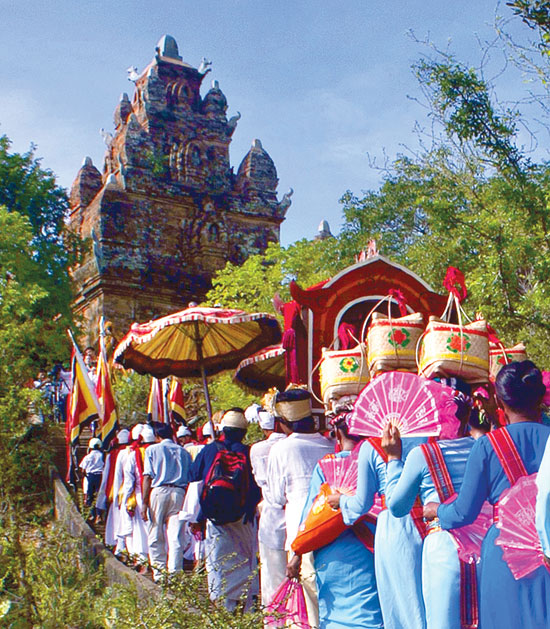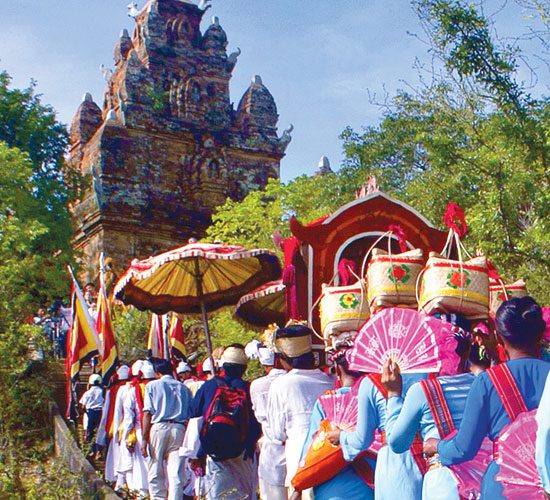No 3, Vol.11 , October – November 2015

Kate Festival at Po Rome Temple, Ninh Thuan Province, 2011. Photo: Truong Van An.
Cham people in Vietnam are named after their religion. There are Cham Ahier (Hindu Cham), Cham Awal or Cham Ba-ni (followers of localized Islam) and Cham Islam (Muslims). The community has two big festivals, Kate and Ramuwan, which is a variation of Muslims’ Ramadan. Islam came to Champa in the 14th century and was localized to become Ba-ni.
Ramuwan is a purely religious festival which takes place in the ninth Muslim month. The time is not fixed on the western calendar, because the Muslim year has 12 fewer days.
Deity Dressing in Kate Festival at Po Klaung Garai Temple, Ninh Thuan Province, 2010. Photos: Truong Van An
Kate takes place in the seventh Cham month. The Cham calendar originated from Sakti, India and differentiates less from western calendar. This year, the Kate of Cham people falls on 11 to 13 October, 2015.
Kate is the biggest festival of the Cham communities in Ninh Thuan and Binh Thuan provinces, making many mistake it for ‘Cham New Year’. In fact, Rija Nugar is Cham New Year, which takes place at the Cham year’s beginning.
Dance performances in Kate Festival in Huu Duc Village, Ninh Thuan Province, 2009. Photos: Truong Van An
During Kate, Cham people go to their temples to conduct their national sacred rituals, regardless of each person’s religion and residence. Ninh Thuan Province has Po Klaung Garai, Po Rome and Po Nugar temples. Binh Thuan has Po Dam temple at Tuy Phong District and Po Sah Inu temple in Phan Thiet City.
People thank heaven, the deities and the ancestors for creating the country and for peace and prosperity. The main rituals of Kate include: Dress Procession, Temple Opening, Deity Bathing, Deity Dressing and Deity Worship. Then they go back to their village and pray at the chief monk’s house. On the third day, they pray at home.
Dance performances in Kate Festival in Huu Duc Village, Ninh Thuan Province, 2009. Photos: Truong Van An
Kate may last till the end of the month. Depending on the regional and private customs of each clan and family, people may conduct the heaven and earth appreciation ritual on different days of the month.
In the past, only those Cham families that had made a ‘promise’ to a deity would make sacrifices to return their debt. The others didn’t take part in Kate. In the last few decades, due to the modern cultural blending, Kate the ritual became Kate the festival. Cham villages open their arms to welcome people from near and far, Vietnamese and foreigners alike. Kate becomes even more vibrant and attractive when both Ninh Thuan and Binh Thuan have Cham performers coming to Cham villages to have fun together with the people after hard days of work.
Kate Festival at Po Klaung Garai Temple, 2010. Photo: Nguyen Phuoc Toan
The most surprising and impressive phenomenon of Kate is the first ritual. The Deity dress is brought not by the Cham, but by the Raglai people, who are of a different ethnicity. Noon of the last day of the sixth Cham month, the Raglai who keep the Deity’s dress in Tra No Village of Phuoc Ha Commune, Ninh Thuan Province, bring it to Huu Duc, the largest Cham village in Ninh Thuan, where Po Nugar temple is located. The next morning, the villagers and senior monk take it in a procession to the temple for the rituals. Here, the Raglai delegation performs their most special dance in the shared ceremony. After that, they go back to the Cham village to celebrate Kate with their Cham brothers and sisters.
Preparing offerings to deities in Kate Festival. Photo: Inrajaya
Raglai and Cham people have been inseparable for centuries. They share living regions, language, business relations and common cultural activities. Today, the Raglai are found wherever the Cham live. The Raglai live in the midlands, so the Cham call them the highland Cham, and they call themselves the lowland Cham.
Cham and Raglai are dialects of Malay. Ede, Churu, Jarai are also dialects of Malay, but Raglai and Cham are much closer to each other. They share almost 90 per cent of their vocabulary; only one uses the vowel ‘a’ and the other use ‘u’, so they can understand each other well. Both Cham and Raglai families are matriarchal, which means women take their husband home. Both of them maintain this family structure today.
Cham dance in Kate Festival. Photo: Ngo Dinh Hong
The Cham have these sayings:
Cham is the elder, Raglai is the younger brother.
Or: Cham and Raglai are like blood brothers.
Raglai is the King’s youngest child.
In a matriarchal family, the last child keeps the property. So, naturally the King’s youngest child must keep the royal dress. All Champa Kings were deified. The royal dress is the dress of Yang God. The God’s statue must be dressed in it during the solemn Kate ceremony of the nation for the chief monk to conduct the rituals. After Kate is over, the Raglai wrap the dress up and take it back home to preserve.
Finally, all festivities involve pilgrimage. Pilgrims from Cham villages come every year without fail to Po Inu Nugar temple, in Nha Trang, Khanh Hoa Province for Kate. This attracts more and more people of other ethnicities. Here, apart from the Raglai, the Viet people also come to make offerings and worship. Over a hundred years ago, when the Cham communities moved southward, the Viet replaced them to perform ceremonies to keep the temple from becoming fallow; thus it became a custom.n
*Inrasara is a Cham and well known expert on Cham culture

